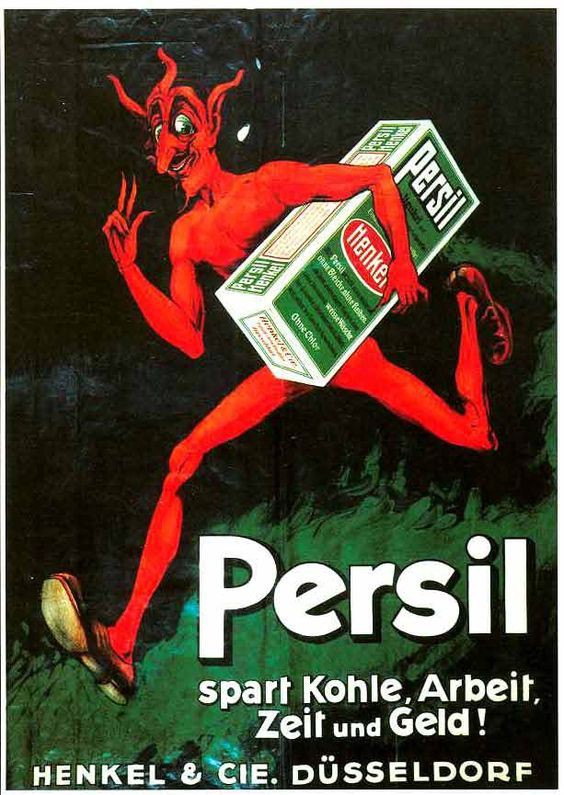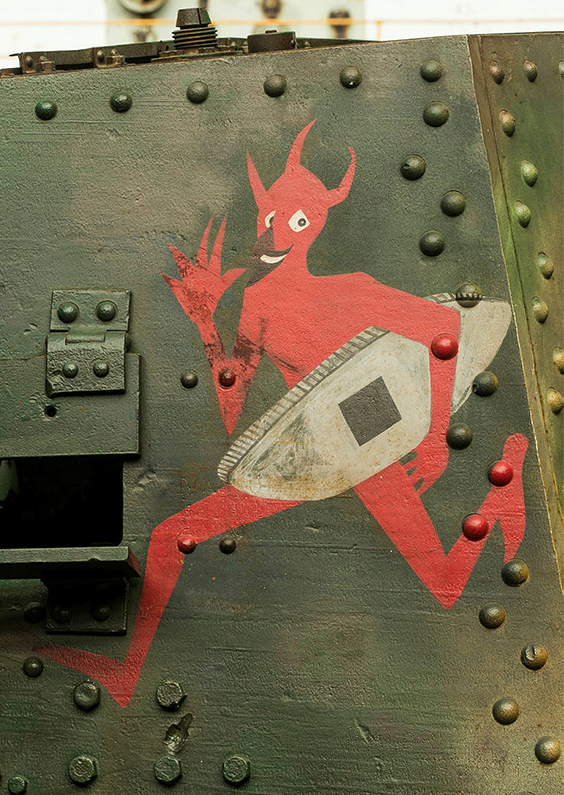By Damien Fegan, Information Officer, Queensland Museum
Among the numerous objects and specimens on display at Queensland Museum are some with truly extraordinary stories! Today Damien Fegan from the Discovery Centre shares new research on one of his favourite objects on display at the Anzac Legacy Gallery.
Mephisto, or more formally, A7V Sturmpanzerwagen (armoured assault vehicle) #506, the only surviving German tank from the First World War (1914-1918), is one of the best-known objects in our collection.
Mephisto was one of the 20 A7V tanks built by Germany, arriving in time for the final German offensive of the war. It was abandoned during fighting at Villers-Bretonneux in April 1918 and later recovered by Queensland troops and shipped home as a war trophy.

The name Mephisto and the cartoon mascot of the devil running off with a British tank tucked under its arm are prominently displayed on the front of the tank, but what is the story behind them?
The practice of giving tanks names starts with the British in 1916 that originally referred to them as ‘Landships’ and consequently followed Admiralty practice of giving each ship a name. This practice is still followed in many armies, with tanks from ‘A’ squadron in a regiment having names starting with A, ‘B’ squadron’s tanks have names starting with B, and so on.
The term ‘tank’ was actually an intelligence ruse to make the Germans think the large metal objects that showed up on aerial reconnaissance photos were portable water tanks rather than weapons. The name stuck!
On the other side of the lines, German tank crews also named their vehicles, though not with the same alphabetical rigor. Alongside Mephisto were Wotan (an ancient Germanic God), Alter Fritz (Old Fritz – a nickname of Fredrick the Great of Prussia), Cyclops (the one-eyed monster of mythology) and others.
Mephistopheles/ Mephisto was the devil in the tale of Dr Faust who sells his soul to gain unlimited knowledge and power. Faust’s deal with devil was well known in German folklore and the subject of a popular play by Johan Wolfgang Goethe. Serving alongside Mephisto was another A7V tank named ‘Faust’. This explains the origin of the name; but when we delve deeper, the story takes some quite unexpected turns.
In 1907, the Henkel Company of Dusseldorf developed Persil, the first modern laundry soap combining a bleach with a detergent. The name Persil came from the two main ingredients, sodium perborate and silicate (per-sil). The sodium perborate formed oxygen bubbles in the water, which according to Henkel’s marketing made laborious scrubbing of clothes on a wash board a thing of the past. The bleach also removed the necessity of sun bleaching whites which were yellowed by laundry soaps. Persil was an instant success and, in a first, was sold in powder form rather than as a soap block and came prepacked in a stout cardboard box.
Fascinating stuff: but what does this have to do with tanks you may ask?
Persil is also the French word for parsley, which has some surprising folk beliefs associated with it. The ancient Greeks and Romans associated parsley with death and burial. Later superstitions claim that parsley seeds travel to the underworld several times before sprouting, with the devil keeping the best for himself. Other traditions warned maidens to never plant parsley, lest they later give birth to the devil’s child. It was considered perfectly safe for a man to plant parsley – but only on Good Friday!
The Henkel Company, aware of the superstitions linking the devil to parsley/persil, used the figure of the red devil in their first campaigns for Persil. Their poster read that Persil “saves coal, labour, time and money!” Presumably, the logic was that unless you use Persil the only other way to get your washing clean was by hard work or a Faustian deal with the devil. 1
The Persil box was also the perfect size for fitting into a mailbox and quickly became a favourite container for German conscripts to mail their civilian clothes back home after they were issued their uniforms. This became such common practice that the call up notice became known as the Persilshein or “Persil ticket.” 2
Persil, and its advertising logo devil was very much a part of popular culture in Germany at the time of the First World War and the Persil Devil figure fitted the name Mephisto perfectly. From there it was a quick job to swap the soapbox under Mephisto’s arm for a British tank. This explains why the demonic mascot of a laundry soap ended up on our German tank!
By way of artistic retaliation, allied troops adorned the side of Mephisto with a large British Lion resting its paw on a diminutive German tank soon after it was captured.
You can see Mephisto for yourself in the Anzac Legacy Gallery at Queensland Museum South Bank and learn more about Mephisto.
1 Persil is still available today under the brand names Persil, Omo, Rinso, Surf and others depending on the location. Sadly, they stopped using the Mephisto logo in the 1920’s.
2 The meaning of Persilshein has changed over the years. In the post WWII de-Nazification of German society it took on the meaning of someone who had a “squeaky clean” background. Since then, it has taken on a more cynical meaning of an official ‘whitewash’ or cover up.
Do you have an interesting question or mystery object? Our helpful and knowledgeable staff can answer your questions through our Ask an Expert inquiry service.



You must be logged in to post a comment.